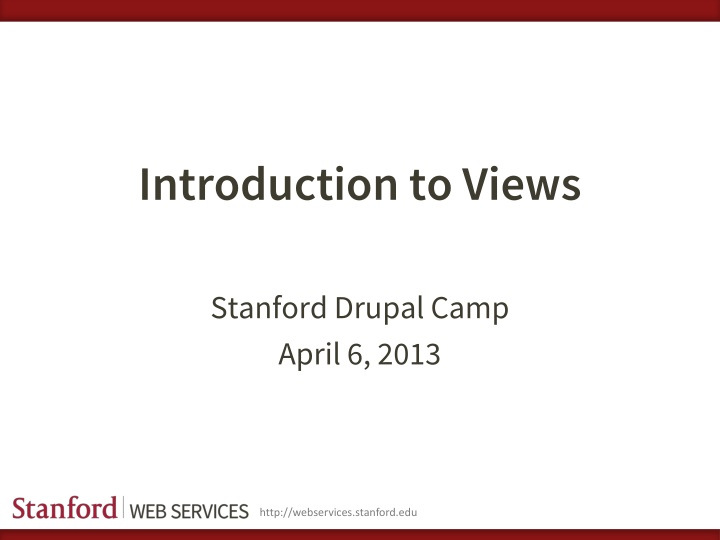
Drupal Views Module: Simplifying Database Queries and Displays
"Discover how the Views module in Drupal simplifies the process of querying databases and displaying data. Learn about enabling and using Views, cloning existing views, building new views, and more. Dive into the world of Drupal with Stanford Drupal Camp resources." (235 characters)
Download Presentation

Please find below an Image/Link to download the presentation.
The content on the website is provided AS IS for your information and personal use only. It may not be sold, licensed, or shared on other websites without obtaining consent from the author. If you encounter any issues during the download, it is possible that the publisher has removed the file from their server.
You are allowed to download the files provided on this website for personal or commercial use, subject to the condition that they are used lawfully. All files are the property of their respective owners.
The content on the website is provided AS IS for your information and personal use only. It may not be sold, licensed, or shared on other websites without obtaining consent from the author.
E N D
Presentation Transcript
Introduction to Views Stanford Drupal Camp April 6, 2013 http://webservices.stanford.edu
Caryl Westerberg Web Producer cjwest@stanford.edu Stanford Web Services Stanford University http://webservices.stanford.edu
What is Views? The Views module is a powerful query builder designed to simplify the task of building custom query displays. - Earl Miles and Lynnette Miles, Drupal s Building Blocks, 2010 http://webservices.stanford.edu
Drupal Databases, Queries, and Displays Stores data in a database Queries the database to retrieve data Uses HTML, CSS, and Javascript to display data HTML CSS Javascript Web Browser Database Query http://webservices.stanford.edu
Views UI for Queries and Displays Simplifies creating database queries Simplifies displaying data Views HTML CSS Javascript Web Browser Database Query http://webservices.stanford.edu
Lets take a look http://webservices.stanford.edu
Getting Started Getting Started Enable Views and Views UI modules (modules page) Views Page Overview Landing page: List of views Go to Structure > Views Disabled views Settings page Master view SQL query Advanced display settings http://webservices.stanford.edu
Clone an Existing View Navigate to views page (structure > views) Find the view and select clone Select save Visit your page No editing needed! http://webservices.stanford.edu
Build a New View Select Add new view Add information about the view o View name o Type of data (Base table) o Page: has a URL o Block: must be placed in a page region Save & exit http://webservices.stanford.edu
Views UI Each section of the user interface defines part of a query and/or how that part will be displayed. http://webservices.stanford.edu
Views UI: Displays A view is actually a combination of displays where each display is a separate but related query. Choices of displays: Attachment, block, feed, page, etc. Operations on the view and displays: edit, analyze, clone, export, reorder, delete, etc. All Displays or Override: Allows a section of a display to be independent from the other displays. http://webservices.stanford.edu
Views UI: Displays Details Title Format o Grid: Select the number of rows and columns o HTML List: Select ordered or unordered o Jump Menu: Creates a Jump menu from a content field o Unformatted list: One piece of content per row. Fields: Select from fields related to the base table to display http://webservices.stanford.edu
Views UI: Displays Details, Cont. Filter Criteria: Reduce the number of results. Can be exposed for use by site visitors Sort Criteria: Sort query results based on fields, etc. Settings: Specify how the results are displayed o Path: URL where the page will display o Access: Restrict access to results by permission or role Header and Footer: Can be text, another view, etc. Pager: Specifies number of results and navigation between multiple displays of results http://webservices.stanford.edu
Views UI: Advanced Displays Details Contextual Filters: allows the display to use arguments from URL, node, etc. Relationships: joins content through related fields for use by the display No Results Behavior Exposed Form: specifies where exposed filters can be displayed Other http://webservices.stanford.edu
Editing a View Change the page title Change the format to fields Add an image to the display Filter by taxonomy Change to sort by title Change the path Add a menu item http://webservices.stanford.edu
Questions? http://webservices.stanford.edu
